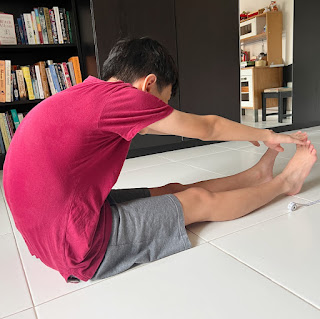I thought it's common knowledge by now that just one static stretch of 30 seconds can reduce your maximum strength. You're more likely to get injured if you do static stretching before exercising.
Maybe that physiotherapist is not alone. An article published in 2020 found that 80 percent of 605 personal trainers surveyed in the United States of America still prescribed traditional static stretching to their clients.
Static stretching is prescribed to help static flexibility. Some readers will recall doing the sit-and-reach test in the NAPFA test in our schools. This is done sitting on the floor with legs out straight and they measure how far beyond your heels you can reach. Best way to improve static flexibility? To do more static stretching. You can go to the end of your available range and hold that for say, 10 seconds and repeat.
If you read that article (Nuzzo, 2020), having good flexibility will not help you live longer. It does not help prevent falls.
Good static flexibility also does not help prevent injuries. This topic has been the studied widely, a few studies have found that there are some benefits, while a few other studies have found that being too flexible is associated with injury. Most do not seem to make much difference.
Static flexibility is not associated with non sports related problems like low back pain.
Most importantly for the readers of this blog, having better static flexibility does not improve your sporting performance. Unless your sport requires a certain range like in gymnastics or if you are trying to become a ballerina. Donaben, our champion cyclist will tell you that time trialling on a bike will require some flexibility to hold that aerodynamic tuck and still pedal with power. The rest of us? Probably not.
If you are a runner, you are unlikely to get injured if you cannot touch your toes. A study found that amongst elite runners (with an average VO2 max of 73 mL/kg/min), the runners who were the least flexible (in the sit-and-reach test) were the most economical runners (better running economy). This suggests that being less flexible is better as this allows your legs to store and return energy (like a coiled spring) with each running stride (Jones, 2002)
So take note that static flexibility is not that important, unless your specific sport requires it. Stretching before, during or after a workout does not prevent subsequent muscle soreness. It does not reduce inury risk either (Herbert et al, 2011).
So what do you do to warm up before your exercise if you do not stretch? The goal of warming up is to physically warm your muscles to make them more pliable as well as get your heart rate up to be ready to deliver oxygen to your working muscles.
Before my run, I'll ride a stationary bike for 10 minutes or just run the first kilometer real slow before picking up the pace. If you're playing badminton or tennis, I'll suggest some lunges, side to side movements, i.e. sport specific movements that you may use while playing.
Want to improve your range of motion? Try strength training instead.
References
Jones AM (2002). Running Economy Is NegativelyRelated To Sit-and-reach Test Performance In International-standard Distamce Runners. Int J Sp Med. 23(1): 40-43. DOI: 10.1055/s-2002-19271
Nuzzo JL (2020). The Case For Retiring Flexibility As A Major Component Of Physical Fitness. Sports Med. 50(5): 853-870. DOI: 10.1007/s40279-019-01248-w
Herbert RD, Noronha MD and Kamoer SJ (2011). Stretching To Prevent Or Reduce Muscle Soreness After Exercise. Cochrane Reviews. DOI: 10.1002/14651858.CD004577.pub3





No comments:
Post a Comment